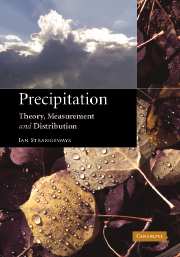Book contents
- Frontmatter
- Contents
- Preface
- Acronyms and abbreviations
- Part 1 Past theories of rain and snow
- Part 2 Present theories of precipitation
- 3 Basic processes
- 4 Cloud formation
- 5 Cloud droplets, ice particles and precipitation
- 6 Lightning
- Part 3 Measuring precipitation
- Part 4 The global distribution of precipitation
- Part 5 Future developments
- Index
- References
- Frontmatter
- Contents
- Preface
- Acronyms and abbreviations
- Part 1 Past theories of rain and snow
- Part 2 Present theories of precipitation
- 3 Basic processes
- 4 Cloud formation
- 5 Cloud droplets, ice particles and precipitation
- 6 Lightning
- Part 3 Measuring precipitation
- Part 4 The global distribution of precipitation
- Part 5 Future developments
- Index
- References
Summary
Lightning was probably the cause of the first fires seen and used by humans, but before Benjamin Franklin it was just a mysterious and terrifying natural phenomenon, although others had been debating the matter before this. In 1752, in addition to all his political activity, Franklin found time, aged 46, to perform his famous kite experiment, in which he established that lightning was due to static electricity, akin to laboratory-produced electrical discharges. This work was published by the Royal Society in London and four years later he was elected a Member. In 1772 he was also elected to the French Academy of Sciences. It is interesting to reflect that despite all of his other work, his world fame resulted from this single experiment and his subsequent invention of the lightning rod.
The clouds that produce lightning
As we saw in Chapter 4, single-, multi- and super-cell cumulonimbus clouds involve powerful convective updraughts producing the highest and most violent of all clouds, generating hail, tornadoes and hurricanes. In addition they also produce lightning. By what process are the clouds charged? This is still undecided and is the subject of ongoing research, but nevertheless a great deal is now known.
The charging process
During a thunderstorm, the upper regions of the cloud become positively charged, with a negative charge near the centre of the cloud at around the −15 °C level in a pancake-shaped layer about 1 km thick, extending over the width of the cloud (Fig. 16.1).
Information
- Type
- Chapter
- Information
- PrecipitationTheory, Measurement and Distribution, pp. 119 - 136Publisher: Cambridge University PressPrint publication year: 2006
